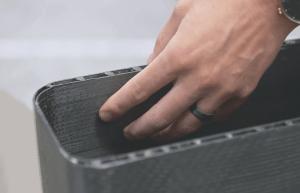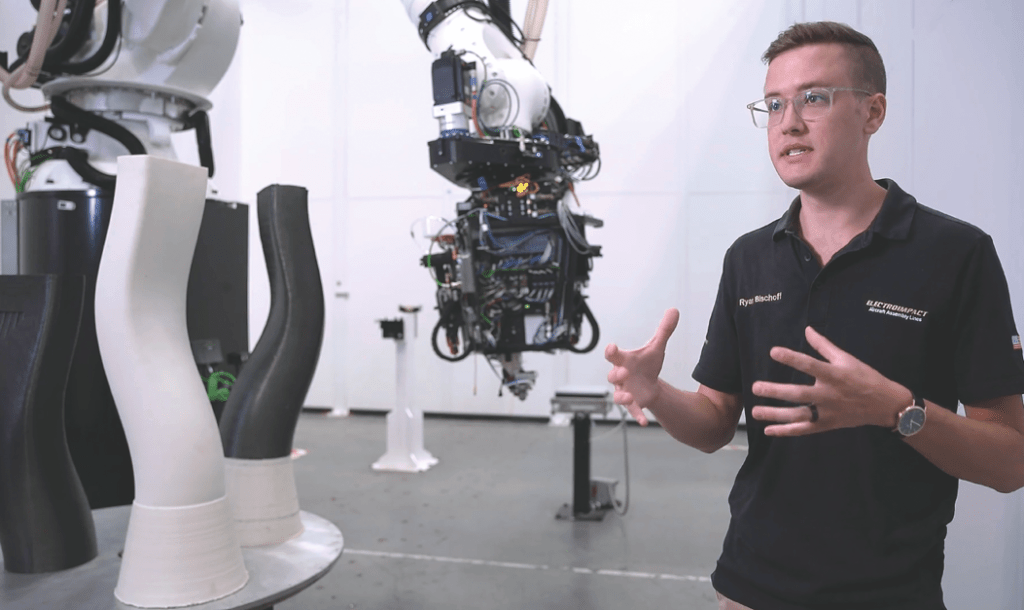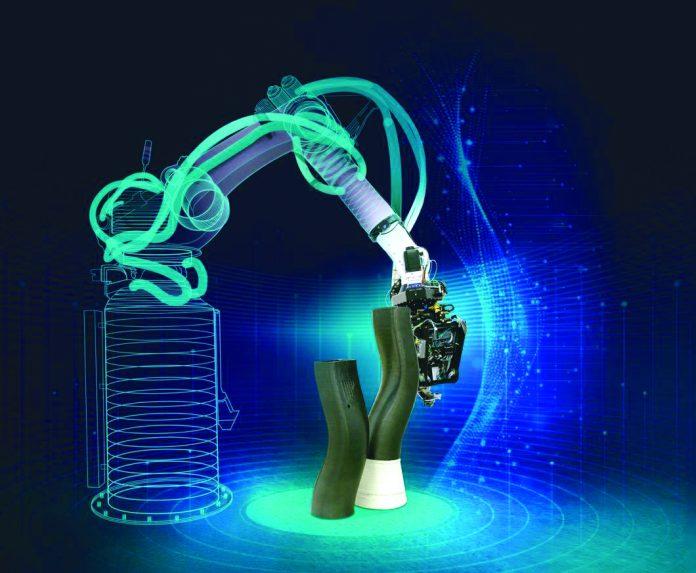This industrial, true 6-axis continuous fiber-reinforced 3D printer enables tool-less rapid fabrication of aerospace-grade integrated composite structures.
Pushing the envelope in additive manufacturing
Aerospace and defense design engineers and the complex components they develop require true manufacturing agility. Shepherding ideas from seeming impossibilities to sparks of inspiration to groundbreaking products that enable innovation can be both exhilarating and maddening. To iterate quickly and enable true collaboration, the fastest teams in engineering employ the Electroimpact SCRAM system powered by the Siemens SINUMERIK ONE CNC.
Helping to make the impossible possible, Electroimpact has integrated an in-situ out-of-autoclave thermoplastic Automated Fiber Placement (AFP) process, an advanced Fused Filament Fabrication (FFF) 3D printing process, a Fused Granulate Fabrication (FGF) 3D printing process, and subtractive machining into a unified Scalable Composite Robotic Additive Manufacturing (SCRAM) system. SCRAM is an industrial, true 6-axis continuous fiber-reinforced 3D printer that enables the tool-less rapid fabrication of aerospace-grade integrated composite structures.
High-performance thermoplastics combined with a high percentage of continuous fiber reinforcement are used to produce parts with exceptional material properties previously unheard of in the world of additive manufacturing. The enhanced performance of the 6-axis system offers unmatched dexterity and flexibility, enabling shapes, accuracies and intricacies not possible otherwise.
This technology has no equal in the industry and is a unique offering available only from Electroimpact. The capabilities and processing speed of the SINUMERIK ONE control empower Electroimpact engineers to achieve these breakthroughs in additive manufacturing.

True 3D printing
Most 3D printing processes are more accurately described as 2.5D printing. The material is deposited successively in flat slices, which when stacked together form a 3D object. In contrast, the SCRAM process renders true 3D printing.
Layers of continuous fiber-reinforced thermoplastic capably take the shape of complex contours, including aerodynamic surfaces and ducts for fluid flow. As a 6-axis process, fiber orientation within each layer can be tailored to the specific application, providing optimal strength and appropriate stiffness distribution throughout the part, much like a conventional AFP system.
In addition to the continuous fiber-reinforced thermoplastic printing process and the FGF support tool printing process, SCRAM cells are also fitted with two FFF nozzles optimized for deposition of thermoplastic material reinforced with short or “chopped” fiber.
A proprietary laser heating system is incorporated, producing exceptionally strong bonds between layers. This process is ideal for situations in which layering continuous fiber is geometrically impossible or otherwise does not make sense. “It allows us to deposit the material exactly where it needs to be and only where it needs to be, achieving the highest possible strength and lowest weight,” says Ryan Bischoff, senior composite engineer at Electroimpact.
This is a true 3D printing process where the layers are not simply a stack of planes. Complex geometries such as variable density core and other internal structures can be printed directly onto continuous fiber-reinforced layers with widely varying curvature. If desired, additional continuous fiber-reinforced layers can then be deposited on top of the chopped fiber-reinforced core structure, forming an upper skin.
The system is an integration of several additive and subtractive processes, combined with Electroimpact’s patented accurate robot, a rotating build platform and a climate-controlled build chamber.
Electroimpact then supercharges everything with the SINUMERIK ONE control from Siemens. “SINUMERIK ONE allows us to run more complicated code much faster,” says Kylie Martineau, Electroimpact controls engineer.
“Electroimpact expanded from doing mostly drilling and fastening to additive manufacturing about 15 years ago,” Bischoff says. “That move and the advancements over the years led to the development of a system that we call a ‘factory in a cell.’ Instead of needing a whole assembly line, with each dedicated machine only performing a single function, it is one system, which can be printing ducts for jet engines one day and a wing component the next. It can be quickly changed and adapted according to needs.”

The SCRAM enables the tool-less rapid fabrication of aerospace-grade integrated composite structures. This factory in a cell gives builders the option to produce low-run parts that make all the difference in their designs.
This might be a carbon fiber element for Formula One racing or a part made from a revolutionary alloy that is destined for space. For short runs or small runs, nothing can compete with this technology. “Here is where the factory in a cell helps teams develop parts much more quickly than a traditional facility. You complete the whole process within the SCRAM system. It makes sense because these are not the kind of parts that are produced in the thousands,” Bischoff says.
“Our customers are doing extraordinary work, and we are right there alongside them,” he adds. “Your Electroimpact engineer is with you though the lifespan of the system for all questions and requests. We are here to help builders push boundaries. We service our equipment till the day it dies. Support is one of the things that Electroimpact does better than anyone else in the industry.”
With the SCRAM system, 3D printing replaces the need for the traditional complex tooling development typically used for automated carbon-fiber layup. This eliminates the inflated cost and time investments needed in traditional tooling and development; therefore, the SCRAM system allows for faster corrections and modifications.
Once the complex tooling is printed, the SINUMERIK ONE control facilitates rapid changes throughout the process. First, the SCRAM system changes to a multi-axis milling head that finishes the form to exacting specifications. Then the SCRAM system changes once again to the 6-axis carbon-fiber placement head and applies the intricate pattern of carbon fiber tape to the support material.
Bischoff explains that the tape is deposited quickly, establishing the form. Next, the support material additive is then completely dissolved away, leaving behind a component in the exact shape the manufacturer needs.
“The knowledge that we’re able to dissolve the tooling without creating graywater brings us great peace of mind,” Bischoff says.
The SCRAM system, with the power of SINUMERIK ONE, also enables iteration. “We are working to make an open system that will support the material choices and make the parts each customer needs. We are driven by customer demand,” Bischoff explains.

The processing speed of the Siemens SINUMERIK ONE CNC
Electroimpact engineers appreciate the advanced features of this next-generation control platform.
“The faster processor times for both motion control and PLC, combined with new functionalities of the SINUMERIK ONE, further enable the incredible work Electroimpact is doing with the SCRAM system,” says Steve Czajkowski, engineering manager at Siemens.
Brian Cubie, account manager for Siemens, agrees. “Our system is the foundation on which they are building, and it is just incredible to experience,” he says. “I have been in robotics for many years, and to see what the engineers at Electroimpact are doing in terms of digitalizing the factory floor is exciting. They are always at the forefront. Electroimpact does a phenomenal job of taking our new SINUMERIK ONE control and adding encoders for feedback and run it though their own kinematics.”
SINUMERIK ONE is built for high-speed processing that enables the accuracy needed for specialized parts. It is ideally suited to the SCRAM’s groundbreaking ability to shift from 3D printing to finishing and continuous carbon-fiber placement, all from one control.
SINUMERIK ONE makes product development faster, more flexible, and more efficient.
 Digital twin technology
Digital twin technology
Looking towards the future, the SINUMERIK ONE control platform will take the SCRAM into advanced digital twin technology. This will help teams engineer a fully functioning machine even before a real-life prototype exists and for teams to transfer tasks from the real world to the virtual environment. It will keep projects moving consistently to the work preparation phase. Having SINUMERIK ONE as a built-in tool will help reduce overhead costs for projects and support.
“There‘s a huge industry push to having a digital twin,” Martineau says. “I am extremely excited about supporting SCRAM in our customers’ endeavors moving forward. Each customer is pushing what is possible. They are reaching for ideas that are slightly out of the ordinary. With this true digital twin, instead of needing to travel for an on-site visit or asking for photos or video footage of their challenges, the PLC will allow simulation right inside the control.”
Just as customers can run the digital twin from their computer, Martineau will be able to operate the digital control of a customer’s SCRAM right from hers.
“We hear from customers when they’re striving for the next level, pushing the system to the max. Being able to jump in and see what’s happening is so valuable,” she says. “The digital twin capabilities of SINUMERIK ONE will enable us to work extremely close to our customers in the future, supporting their desires to push the envelope of product development. With digital twin technology this accurate, customers will benefit from knowing we can jump in anytime to seamlessly help troubleshoot.”
Strong partnership
Siemens and Electroimpact have been partners for more than 10 years. The SCRAM previously included the SINUMERIK 840D sl, a precision CNC control highly favored by the aerospace industry. SINUMERIK ONE is faster and excels at more complex code. With the advancements of the SINUMERIK ONE control, the possibilities are endless.
“Electroimpact is always pushing the envelope,” says Brian McMinn, head of the Siemens Machine Tool Systems business. “Their approach is to always be at the very leading edge of manufacturing technology. We are glad to be a part of their team as SINUMERIK ONE has the power and speed to make it all possible.”
Expect to see further advancements from Electroimpact in the next few years that raise the bar even higher for complex aerospace design and development.
The SINUMERIK ONE control will continue to evolve and support the next wave of design and development in machine building.



















